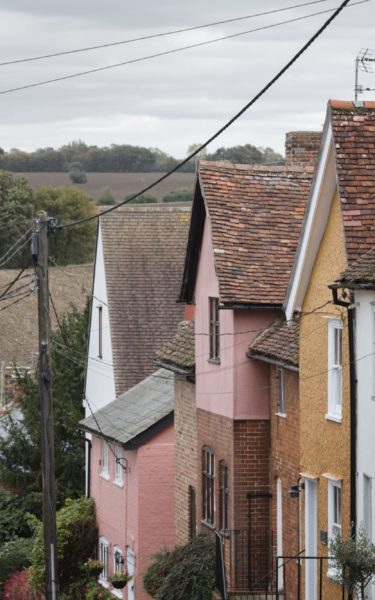How to make your home more sustainable.
If you’re an existing mortgage customer with Suffolk Building Society, you could apply for one of our Green Further Advance mortgages to help undertake projects in your home to make it more energy efficient.
Homeowners and renters are balancing household budgets against a backdrop of rising energy wholesale prices and the highest cost of living rises seen in 30 years. Now more than ever, it’s important to make sure we’re doing all we can to help the environment and keep the bills down.
The UK’s aging housing stock accounts for roughly 20% of the nation’s CO2 emissions, with ONS data showing that houses built before 1900 have an E rating on average.
We all know we should turn the lights off when we leave a room, switch to low-energy bulbs and only fill the kettle up enough for the cuppa we want. But what are the bigger ticket items that can help?

Mortgages
Investing in a ‘green’ project for your home.
The 2022 Spring Budget removed VAT on energy-efficient additions homeowners can make to houses, such as solar panels and heat pumps. This still won’t suit everyone’s budget and some are more expensive than others, which means it will take longer to see a return on the savings you make with your monthly bills.
However, for homeowners and landlords looking to undertake a project and make their home more sustainable – we’ve included an introduction to some of the things you could do below.
Please note, as with any green investment in your home, you need to think about how much you might save in your energy bill over time compared to the initial outlay before you see a return on your investment.
If you’re looking to move home soon – you might want to think carefully about how much money you invest into such a project. However, these items can cut your utility bills and reduce your carbon footprint – which is great news for yourself and the environment.
Green Further Advance Mortgages
Green projects you could undertake in your home
Houses older than 20 years old may not have cavity wall insulation. Homes can lose up to a third of their heat through walls, so it can be a very important improvement to make. The costs vary depending on the size of your house. The Energy Saving Trust (EST) estimates the typical cost for a detached house at £610 – however this will vary depending on the materials used. Polystyrene bead insulation and mineral wool insulation are cheaper than expanding foam – for example. It’s also important to consider that the type of property will have an effect. A mid-terrace house has fewer outside walls than an end terrace of course. How easy it is to access the location is important too, and if the cavity area needs to be cleaned of debris before the insulation can be added. However, this project will stand most properties in good stead for the future in terms of heat loss.
Around two thirds of the energy lost through a traditional window is due to radiation through the glazing. Modern windows have a cavity filled with argon gas, which cuts down on heat loss through conduction and convection. The energy improvements switching from single to double glazing is significant, with the efficiency jump in triple glazing being less.
Triple glazing does bring some other benefits though. If you’ve already got a well-insulated house in terms of your walls and floor, a double glazed window could see some ‘cold spot’s surrounding the window at night – resulting in streams of condensation. There are also other benefits in terms of noise reduction and reduced risk of condensation – which might be important for many people. This project can be pricey and it might be best to think of it in terms of your overall comfort and how you want to feel living in your home, rather than the specifics of your carbon footprint.
Solar panels, also known as photovoltaics (PV), capture the sun’s energy and turn it into electricity for your home. You can receive payments for any extra energy you generate. Each panel contains layers of semi-conducting material. As the sun’s light hits them, this is how the conduction of energy works. You do need to think about the space on your roof – most systems will take around 15-20 square meters. Location is also an important factor. Having a south facing roof with no shade is ideal. A system that faces East or West will yield less energy, but will still work. North facing roofs are not recommended. You don’t need planning permission to install them.
There has been a lot of talk around air source heat pumps in recent months and years. In short, these devices offer an alternative way to heat your home by generating renewable heat. They take heat from the air outside and turn it into a liquid – at a low temperature.
They then use an electric compressor to heat it up higher. The heat is sent as a liquid to radiators and underfloor heating. Any excess can be stored in a hot water cylinder. In essence, they’re a bit like a fridge in reverse. They deliver heat at lower temperatures than traditional gas and oil boilers, so you’ll end up running them for longer to keep your house as warm as you might be used to – but it should use less electricity than the heat produced, meaning it’s energy efficient. It should be noted that these are one of the more expensive projects to undertake, so how long you will remain in your home is a factor.
Anyone’s energy bill will be dominated by heating and hot water costs, so doing this in the most efficient way possible is an important factor when looking at how to make your home more sustainable. Modern boilers are more efficient than older boilers as they ‘condense’, meaning they recover more heat from the hot gases that escape up the pipe used to extract fumes and supply fresh air to the boiler.
If you have a mains gas connection, a modern condensing gas boiler could work well – but it should be noted that the cost of wholesale gas is on the rise. If you’re all electric, a modern cylinder unit could be a good investment. Updating your boiler will be a cheaper project than installing solar panels or a heat pump, although this will be more of an evolution rather than a revolution in how you heat your home.
Many of us will have been installing energy efficient bulbs as our old ones give up the ghost. Companies are not allowed to make new halogen lights, which are inefficient. But shops may well be selling off old stock. It’s important to read the packaging as you’re buying new lighting. For most of your general lighting, look to LED or CFL bulbs – same for outdoors. For spotlighting, look to get LED spots and for dimmable lighting go LED or B-rated halogen. If you have a crystal chandelier, LED lighting will do the job.
Charging an electric car or plugin hybrid at home will likely be the cheapest way to charge your car. It’s also very convenient. With rising fuel prices, this will be a cheaper way to fuel a personal vehicle too. You will need a driveway or a garage and a way of getting power to it.
Using a standard three pin plug simply won’t cut it, so you’ll need a wall mounted charging unit, or ‘wallbox’, installed so you can charge much more quickly. A ‘tethered’ wallbox has the power lead attached to it and means you can plug in immediately without getting your car’s power lead from the boot.
Picking one with a lower power rate might save you some money on the initial installation, but it will take longer to charge your car. Getting a ‘smart charger’ could be a good idea if you’d like to charge your vehicle remotely from your smartphone, or if you have a cheaper ‘off peak’ electric tariff. Getting a wallbox installed could be one of the cheaper projects to undertake compared to some of the others here, so long as you can afford to upgrade your car to electric too.
These systems can be installed to store rainwater which can be used to flush your toilet. This isn’t insignificant, as toilets can use around 6-12 litres of water on a flush. It’s also possible to use the water for washing machines and irrigate the garden. If you’re on a water meter, this can cut your bills. And you won’t be as reliant on the mains.
Collection systems tend to be installed on the roof of a property – because it’s closer to guttering and it’s also easier to then get the water to a storage tank. Water is pumped from the storage container to where it’s needed. Specialist suppliers will be able to advise on your individual property and the best place to install the harvester. Obviously this project won’t reduce your heating bills or insulate your home any better but it’s another way to look at updating your home.
Installing a wind turbine in your own home is now a real possibility. They can be pole mounted in a freestanding position or mounted on a building. The latter is a smaller system and will generate less energy. These can cut your carbon footprint and if you also install a battery, you can store excess energy for another day. As a project, these are more expensive – with a pole mounted solution as around £23,000-£34,000. However, you could look to cut both your bills and your carbon footprint.
Green Further Advance
Green Further Advance mortgages criteria.
Here’s some of the key things you should know about our Green Further Advance mortgages.
- To qualify for the green additional borrowing products, borrowers must have an existing mortgage with Suffolk Building Society.
- 50% of the loan must be spent on approved green home purchases which are: Solar panels, traditional insulation, air source heat pumps, rain water harvesting, double/triple glazing, low energy lighting, boiler upgrades, wind turbines or electric car charging stations.
- Borrowers will need to provide a quotation from a supplier for the work that they intend to carry out to be legible for the green additional borrowing products.

Find a mortgage
Mortgage finder
If you’re an existing mortgage customer with Suffolk Building Society, you could access funds to undertake a green project to make your home more energy efficient with our Green Further Advance mortgages. We’ve created these products to help people to undertake projects in their home to make them more energy efficient.

Speak to an expert
Get in touch
Get in touch with us to speak to a mortgage exert and find out how you could possibly undertake a green project for your own home.
With any green project you undertake in your home, think carefully about how much you might save in your energy bill over time compared to the initial outlay before you see a return on your investment. If you’re looking to move home soon – you might want to think carefully about how much money you invest into such a project.






